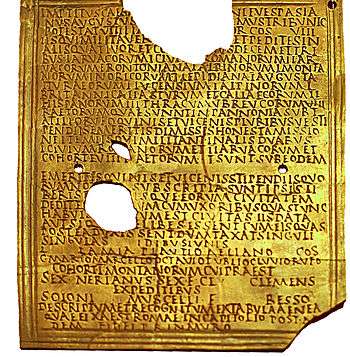Honesta missio
The honesta missio was the honorable discharge from the military service in the Roman Empire. The status conveyed particular privileges (praemia militiae). Among other things, an honorably discharged legionary was paid discharge money from a treasury established by Augustus, the Aerarium militare, which amounted to 12,000 sesterces[1] until the Principate of Caracalla.[2]
.jpg)

 | |
| Part of a series on the | |
| Military of ancient Rome | |
|---|---|
|
|
|
| |
The honorably discharged legionary also presumably received a certificate after a service of approximately 20 to 26 years. Only a few have preserved, called tabulae honestae missionis, because they might have been made predominantly from transient material.
Auxiliary soldiers, called peregrini (non-Roman citizens of the Empire), usually received along with an honesta missio Roman citizenship and conubium (permission to marry[3] for themselves and their descendants.[4] The imperial order about these grants were often documented on bronze military certificates, which might also include rights to cash and land, poll tax exemption for up to four people, and immunities from various duties. For example, recipients who desired to set up a business could receive a cash grant, and those desiring land could be given a sizable plot along with two oxen, cash, and 100 measures of assorted grains. These benefits would be reduced over time.
Other types of discharges included a premature discharge for health reasons (missio causaria) and a dishonorary discharge (missio ignominiosa).[5]
See also
- Donativum, a cash "gift" from a new emperor to secure the loyalty of troops
- Economics of the Roman army
References
- Alföldy, Géza; Mann, J. C. (2000). "Honesta Missio from the legions". Kaiser, Heer und Gesellschaft in der Römischen Kaiserzeit: Gedenkschrift für Eric Birley. Franz Steiner Verlag. p. 153. ISBN 978-3-515-07654-8. Retrieved 26 July 2017.
- Phang, Sara Elise. Roman Military Service. p. 163.
- Phang, Sara Elise (2001). The Marriage of Roman Soldiers (13 B.C.-A.D. 235): Law and Family in the Imperial Army. BRILL. p. 84. ISBN 978-9-004-12155-3. Retrieved 28 July 2017.
- Andreas Pangerl (17 January 2015). "Roman Military Diploma Museum: Introduction". romancoins.info. Retrieved 24 July 2017.
- Watson, George Ronald (1985). The Roman Soldier. Cornell University Press. p. 124. ISBN 978-0-801-49312-6. Retrieved 26 July 2017.
Bibliography
- Phang, Sara (2008). Roman Military Service: Ideologies of Discipline in the Late Republic and Early Principate. Cambridge University Press. ISBN 0-521-88269-9.
- Millar, Fergus (2004). Rome, the Greek World, and the East: Government, Society and Culture in the Roman Empire. University of North Carolina Press.
- Swan, Peter Michael (2004). The Augustan Succession: An Historical Commentary on Cassius Dio's Roman History Books 55–56 (9 B.C–A.D. 14). Oxford University Press.